Physical Address
304 North Cardinal St.
Dorchester Center, MA 02124
In the previous edition, this chapter stressed the importance of infectious disease cytology to the education of pathology trainees and practitioners. Within the contents of the chapter, are illustrated cases intended to demonstrate the value of the following:
A cytopathologist with experience and interest in infectious disease.
Rapid onsite evaluation (ROSE) to provide immediate presumptive diagnoses and ensure proper use of cultures and/or molecular testing.
Workhorse (hematoxylin and eosin [H&E] and Romanowsky) stains, as well as judicious use of so-called special stains, performed in a fashion suitable for cytologic preparations.
Last but far from least, the importance of close communication between microbiologists and cytopathologists.
It is my opinion that, equally essential to quality patient care, is a pathologist who involves himself/herself with clinical medicine and interacts with patients as well as clinicians, radiologists, and endoscopists, thus becoming part of an integrated team of physicians devoted to providing the best patient care. Especially in a teaching hospital, an onsite pathologist has the opportunity to review images and differential diagnoses with the radiologist (or endoscopist), as well as obtain important information directly from patients.
There are caveats that need to be addressed. In response to much-needed efforts to cut medical expenses, we risk throwing the baby out with the bathwater. Some believe that cytopathologist participation in ROSE is unnecessary and ROSE should be used for adequacy assessment only. My response is that, particularly for infectious disease diagnosis, adequacy is inadequate. ROSE is essential for triage, aimed at distinguishing infectious and/or inflammatory conditions from neoplasia and ensuring proper processing of samples. Pathologists should guide the radiologist toward procurement of material required for definitive diagnosis, such as cultures, molecular studies, core biopsies, and flow cytometry, and should work in partnership with clinical microbiologists to ensure optimal material is submitted for culture and/or molecular studies. This mode of practice should be taught to pathology trainees. There should be a “culture” of communication between cytopathologist, radiologist/endoscopist, clinical microbiologists, and clinicians.
During the period between the publication of the first and second editions of this book, it was determined that our cytopathology laboratory should no longer perform its own Gram, acid-fast, and fungal stains and that a limited number of stains should be performed by the standard histologic techniques used in surgical pathology. The Gram-Weigert stain, which we found very useful for actinomycetes and nonviable or treated gram-positive organisms, is no longer performed. Although this decision was likely made to streamline and cut costs, it is my belief that special stains for cytology should be performed by methods suited to air-dried (postfixed in methanol) or ethanol-fixed smears and cytospin preparations. Relying on histologic techniques may not be optimal for smears and may delay turnaround time for reporting. For this reason I have decided to leave the appendix to this chapter in place for those who would like to take advantage of it. Note that all of the cytology illustrations given in this chapter are from stains performed within the cytopathology laboratory.
Finally, to be in compliance with the zeitgeist, the spelling of the Romanovski (stain) has been changed to Romanowsky, the usual spelling used in the United States. One should acknowledge that Romanowsky (stain) was the name of a Russian physician; the Cyrillic alphabet spelling is Романовский, and the name can be spelled in several fashions using the Latin alphabet.
Despite its potential benefits to patients, infectious disease cytology is often relegated to the pathology education back burner. This is unfortunate because accurate diagnosis of infectious and inflammatory diseases (IIDs) by cytology can be lifesaving and involves noninvasive or minimally invasive procedures. ROSE not only can guide in the procurement of appropriate cultures but can allow for instigation of empiric therapy when needed.
Infectious diseases not infrequently manifest with signs that mimic those of neoplasia, and an experienced cytologist should be as knowledgeable about the clinical and morphologic features of infectious diseases as he or she is familiar with the morphologic patterns of neoplasia. For example, in Fig. 4.1 the following gloomy prognostication was rendered on the basis of computed tomography (CT): “Large malignant neoplasm destroys the first rib and sternum and extends and invades the mediastinum and the pectoralis muscles.” However, a fine-needle aspiration (FNA) of the pectoralis mass ( Fig. 4.2 ) led to a presumptive diagnosis of caseating granuloma on the basis of onsite evaluation. An aliquot of aspirated material was then submitted to the microbiology laboratory for bacterial, mycobacterial, and fungal cultures, which identified Mycobacterium tuberculosis . Follow-up CT, after appropriate therapy, showed significant improvement with marked decrease in the size of the mass.
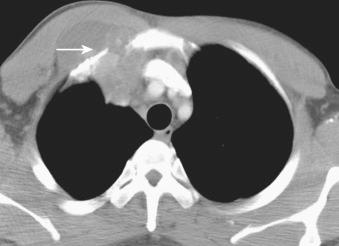
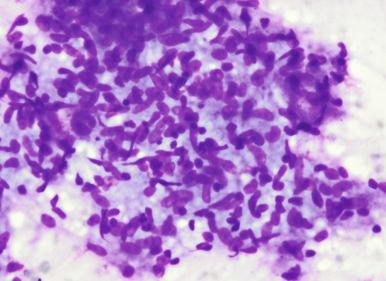
To accurately diagnose infectious diseases by cytology, one must do the following:
First and foremost, think about the possibility of infection.
Have adequate knowledge of the patient's clinical presentation, immune status, and results of any imaging studies performed. At our institution, trainees typically review the electronic medical record prior to both palpation- and image-guided FNA procedures; this is considered an essential part of trainee education.
Be able to recognize inflammatory patterns by cytology and know what types of infection to suspect based on the type of inflammatory cell reaction, combined with the clinical and radiologic findings.
Be able to appropriately culture and request indicated special stains.
Some infections, such as Strongyloides stercoralis hyperinfection, are medical emergencies that necessitate immediate action. Others, such as tuberculosis, are communicable diseases that, when suspected, require notification of infection control personnel and the primary caregivers, as well as appropriate cultures or molecular studies to establish or rule out infection by M. tuberculosis . Scrape or touch preparations of cutaneous ulcers, stained by Romanowsky method, can provide onsite diagnosis of infectious processes and provide material for microbial cultures, thus precluding necessity for biopsy. FNA and touch or scrape preparations are highly useful, albeit underused, stratagems for diagnosing infectious diseases in the autopsy suite. Their use obviates the necessity for, and potential contamination of, the cryostat and helps to confirm or exclude communicable disease in the preliminary autopsy diagnosis.
We have diagnosed infections and unusual nonneoplastic conditions from all types of samples submitted to the cytopathology laboratory, including sputum, bronchial brushings and washings, body cavity and cerebrospinal fluids, bronchoalveolar lavage (BAL) samples, transbronchial FNA, both bronchial and gastrointestinal endoscopic ultrasound, and percutaneous FNA. Most infections can be presumptively diagnosed, or at least suspected, by using a combination of the two workhorse cytology colorants, the Papanicolaou and Romanowsky stains. These two stains make an excellent team for diagnosis of IIDs, as well as neoplasia. The advantage of these two dye combinations over the so-called special stains is that they allow one to assess the type of tissue reaction found in the sample, as well as recognize the presence of infectious organisms. The tissue reaction is of great importance and is discussed later in this chapter. Detailed discussions of the stains used for diagnosis of IIDs are given in other references. Briefly stated, the Papanicolaou stain is similar to the workhorse of histopathology, the H&E stain, with the following exceptions. It is performed on preparations that are wet-fixed in alcohol, most commonly 95% ethanol. This technique coarsens and sharpens nuclear chromatin and produces a translucency to the stained preparation that allows one to examine relatively thick cell preparations at various levels of focus. As with the H&E preparation, the nuclear stain is hematoxylin that has been alkalinized to give a bluish color to the cell nuclei. In contrast to H&E, there are three cytoplasmic stains: eosin, light green or a lead-free equivalent, and orange G. Moreover, the Papanicolaou stain often colors mucin a purple-to-red color, which is useful for recognition of Cryptococcus and allergic mucin (see later discussion).
The Romanowsky stains comprise a number of eosin-thiazine metachromatic stains, including Wright, Giemsa, May-Grünwald, and the rapid variants commercially available as Diff-Quik, Quik-Dip, and so on. Romanowsky stains are usually performed on air-dried slide preparations that are postfixed in methanol. Because of the air-drying, the nuclear and cytoplasmic texture is not as crisp; however, because cells are more thinly spread out over the slide and have more surface area in contact with the slide, there is less cell loss. The Romanowsky stain supplements the Papanicolaou by highlighting features that are not well seen with the former. Cell chromatin pattern and cytoplasmic texture are best seen in the Papanicolaou stain, making it advantageous for cancer diagnosis. Certain fungi, nematode larvae, and ova are also best seen with the Papanicolaou stain. Romanowsky is ideal for characterization of leukocytes, and it is an excellent stain for bacteria and certain other fungi, such as Histoplasma and Pneumocystis (see later discussion). Mucin, colloid, and cytoplasmic granules are best distinguished with this stain. Romanowsky stains can also be performed on slides wet-fixed in ethanol; nuclear features are better visualized; however, cells will appear smaller, and there will be greater cell loss.
A small number of ancillary special stains are useful for the diagnosis of infectious agents. Prior to 2015 at the University of Texas Medical Branch Cytology Laboratory, most of these were performed in the cytopathology rather than the histopathology laboratory. With the exception of the Grocott-Gomori methenamine silver (GMS) stain, the methods used in cytopathology are designed for smear and cytocentrifuge preparations rather than paraffin-embedded sections.
For suspected bacterial infections, Gram staining is performed on air-dried, heat-fixed, very thinly prepared smears or on cytocentrifuge preparations, using techniques adapted to the microbiology laboratory. Classically, the air-drying and heat-fixation was the preferred method for Gram stain preparation; however, postfixation in methanol has been reported to result in less cell loss and better clarity. Air-drying prior to fixation is still recommended.
For suspected Nocardia or Actinomyces infections, we previously used a modified Gram technique, the Gram-Weigert stain. The Gram-Weigert was designed as a tissue fibrin stain and is rarely used today, but it is an excellent stain for gram-positive bacteria, especially actinomycetes. The latter are often very faintly colored by the standard Gram stain. In addition, even senescent gram-positive bacteria retain their blue color. As an added bonus, Pneumocystis cyst forms and Histoplasma capsulatum yeast forms are well stained by the Gram-Weigert technique, which substitutes a mixture of aniline and xylene for acetone alcohol as a decolorant. The obvious disadvantage of the Gram-Weigert stain is the necessity to decolorize under a chemical hazard hood. In addition, it is not good for the identification of gram-negative bacteria.
For suspected mycobacterial infections, we used a cold Kinyoun stain rather than the standard Ziehl-Neelsen acid-fast stain. The Kinyoun stain does not require heat, uses a higher concentration of fuchsin and phenol, and colors M. tuberculosis and mycobacteria other than tuberculosis (MOTT). It is easily modified for Nocardia by shortening of the decolorization time and substitution of a 1% sulfuric or 1% hydrochloric acid solution for acid alcohol.
Fluorochrome stains are typically used in microbiology laboratories and are ideal for large-volume, low-power screening for mycobacteria. Auramine orange has been used to assess FNA for some mycobacteria. A disadvantage of fluorochrome dyes is that they require a fluorescent microscope. In addition, some MOTT, especially Mycobacterium fortuitum , may not be seen with fluorochrome stains.
Nonspecific fluorescent stains, such as Calcofluor white, have been used for wet preparation and cytologic identification of Pneumocystis and other fungi. Specific immunofluorescent techniques have also been used with varying amounts of enthusiasm.
The GMS, the classic stain for fungi, including Pneumocystis , is much beloved and demanded by clinicians and formerly loathed by histotechnologists. Microwave histotechnology greatly simplified this rather cumbersome procedure. Automated staining machines are currently widely used in histology for special infectious agent stains; however, automation may limit one's ability to modify staining techniques to accommodate different types of specimens. Although automation can provide time-efficient, high-quality, standardized staining for surgical pathology and for Papanicolaou-stained cytology samples, whether or not quality of automated special stains for infectious agents on cytology samples compares well to stains designed for air-dried and ethanol-fixed smears is not clear. We have satisfactorily used the manual microwave modification of the GMS technique, with the caveat that a good-quality GMS is a joy to interpret, whereas a poorly performed GMS is nearly useless. In reality, GMS is not always the best choice among the cytologic fungal stains, as discussed in later sections of this chapter. There is no substitute for an experienced technologist who understands the characteristics of a good-quality GMS, whether it be performed by hand or machine. There must be a culture of cooperation and communication between histotechnologist and pathologist to ensure good-quality staining.
An overstained and a correctly stained GMS are illustrated in Fig. 4.3 . Our former protocols for GMS and processing of both BAL samples and induced sputa are provided in the appendix of this chapter.
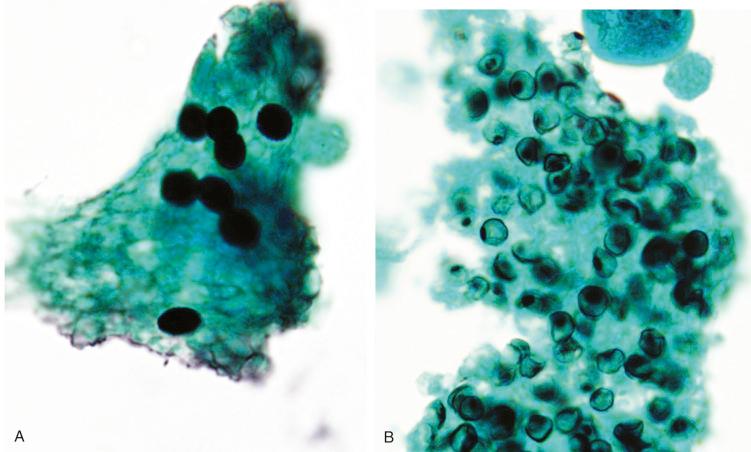
We used commercial or homemade smear preparations as controls for all of our special stains, with the exception of the GMS, for which we used paraffin-embedded sections of lung with Pneumocystis . The latter is used mainly out of convenience and did not seem to be problematic. Either spit or a buccal scrape makes an excellent control for the Gram or Gram-Weigert stain. Commercial smear preparations containing both acid-fast and non–acid-fast bacteria are used for our Kinyoun and modified Kinyoun stain controls. A blood smear is a good control for the Romanowsky stain.
There are a few histology stains that we occasionally use for diagnosis. These include the following:
Mayer mucicarmine, a mucin stain that is useful for confirmation of encapsulated forms of Cryptococcus .
Fontana-Masson melanin stain for paucicapsular Cryptococcus and dematiaceous fungi (pigmented fungi associated with chromoblastomycosis, phaeohyphomycosis, and allergic fungal sinusitis).
Periodic acid–Schiff (PAS) with diastase, a nonspecific mucopolysaccharide stain that can be useful in the diagnosis of pulmonary alveolar proteinosis (PAP) and malakoplakia. Because there may be loss of material from the slide during diastase digestion, we prefer to submit material for PAS-diastase staining on charged slides.
Immunohistochemistry techniques for Pneumocystis are also available.
Samples of brushings, washings, lavage fluids, and FNA are prepared in the same way as for routine cancer diagnosis. For brushing slides, a portion of the slide material can be retained unstained for special staining; however, acid-fast, GMS, and Gram-Weigert stains can be performed over the Papanicolaou after rehydration of the slides back to distilled water. It is not necessary to decolorize the nuclear stain. We have not had sufficient time to assess whether restaining or staining of smears by automated methods is as reliable as by our previously used methods. Restaining is the more effective method if there is only a limited number of slides, because the quality of material present on different slide preparations may vary. We prefer to perform special stains on slide preparations already shown to have inflammatory material suspicious for infection. Cytocentrifuge preparations performed on FNA needle rinses or on centrifuged body fluids are also excellent for staining. The former requires that there be adequate inflammatory material in the rinse fluid. If the cytocentrifuge preparations are paucicellular, restaining of smear preparations is preferable. Cytocentrifuge preparations have the advantage of yielding thin, evenly distributed cellular material. A very thin slide preparation is essential for a good-quality Gram stain.
Induced sputum samples from immunocompromised patients are sometimes submitted to the cytopathology laboratory to be evaluated for Pneumocystis jiroveci . We process sputa by first adding a mucolytic agent, 10% dithioreitol, centrifuging the sample, and then preparing cytocentrifuge preparations including Papanicolaou, Romanowsky (Giemsa), and GMS-stained slides. We currently use a rapid Romanowsky technique rather than the more cumbersome standard Giemsa stain. (Note that Diff-Quik is a brand name for one of many commercial rapid Romanowsky stains rather than a generic type of metachromatic dye). Cytocentrifuge preparations of concentrated sputa, fluids, and BAL samples provide well-concentrated, thin, circular sample preparations that can be evaluated for inflammation, fungi (including Pneumocystis ), and other microorganisms. Fig. 4.4 illustrates a cytocentrifuged, Romanowsky-stained sputum sample from an acquired immune deficiency syndrome (AIDS) patient that contained both Strongyloides larvae and scanty Pneumocystis . Note that the intracystic bodies, not the cyst, are stained by the Romanowsky method. Our protocol for processing sputa for IIDs is given in more detail in the appendix to this chapter.
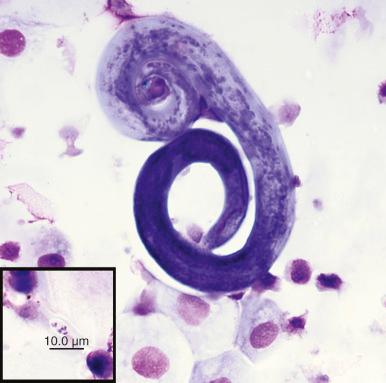
In general, only FNA material is submitted to the microbiology laboratory by the cytopathologist, so the discussion here is limited to methods for submitting FNA samples for microbial cultures.
When FNA yields several milliliters of white-yellow creamy or granular material, one suspects purulent inflammation, caseous necrosis, or coagulative necrosis. Purulent inflammation consists of a mixture of neutrophils, macrophages, and necrotic debris. Caseous necrosis (sometimes called bland necrosis) often has a more crumbly dry or granular appearance, and coagulative necrosis, often associated with keratinizing squamous cell carcinoma (SCC) or high-grade lymphoma, may yield material that is grossly indistinguishable from purulent inflammation. ROSE can help to exclude cancer-associated coagulative necrosis and eliminate the need for cultures. Fig. 4.5 illustrates the difference between necrosis from a bacterial abscess ( Salmonella enteritidis was cultured) and coagulative necrosis and apoptosis from a necrotizing large B-cell lymphoma. Compare the neutrophil-rich inflammation with presence of bacilli in Fig. 4.5A and B with the presence of cell outlines of coagulative necrosis and apoptotic bodies in Fig. 4.5C and D . The former was sent for cultures, and the latter was shown to be predominantly B-lymphocytes by immunochemistry and confirmed as large B-cell lymphoma by biopsy. If in doubt, it is best to err on the side of caution and submit an aliquot of FNA from suspected infections for aerobic and anaerobic bacterial, fungal, and mycobacterial cultures. If limited material is procured, one should use ROSE to guide the sample processing. The cytologist should collaborate with the microbiology laboratory personnel. Culture techniques and methods should be discussed and should be mutually acceptable to professionals working in both areas.
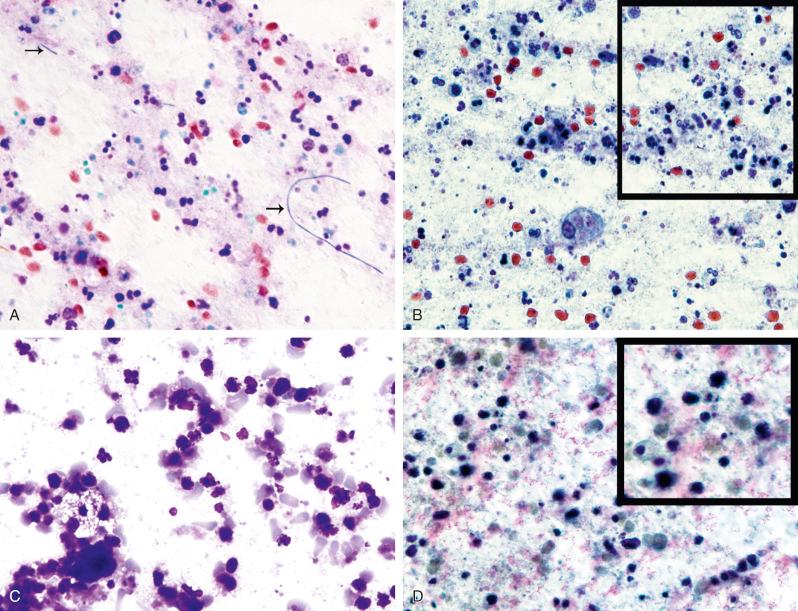
The cytopathologists and radiologists who submit material for culture must discipline themselves to provide adequate clinical information to aid the microbiologist. The exact site from where the specimen came, the types of culture requested, and the pertinent history should be provided on the request form. It is important to notify the laboratory of any specific organisms suspected, because processing of the sample may vary if unusual organisms are suspected. For example, if one sees evidence of Actinomyces infection, the laboratory will incubate the anaerobic culture broth longer than usual before reporting the culture as negative. If organisms whose culture forms are potentially hazardous to microbiology personnel, such as Coccidioides immitis , are seen, it is considerate and professional to inform the laboratory.
Culture of FNA for bacteria requires either the proper type of transport medium or immediate inoculation of culture broth onsite. If one chooses to use transport medium, various tactics must be used to submit samples for aerobic and anaerobic cultures. We prefer, whenever possible, to perform or request that the radiologist perform a dedicated pass for microbial cultures after ROSE confirms inflammatory material in aspiration site. If 5 mL or more of purulent-appearing material is aspirated, several drops of sample should be expelled into a vial of anaerobic transport medium. There are several commercially available types of anaerobic transport kits, and it is best to obtain and use the type that is used by the microbiology laboratory. The remaining material can be expelled from the syringe into a sterile specimen cup and submitted to the laboratory for aerobic, fungal, and mycobacterial cultures. Swab transport kits are also available for submission of material for aerobic culture; however, swabs should not be used to send samples for either mycobacterial or fungal cultures.
If scanty material is aspirated, one can rinse the needle in approximately 5 mL of sterile saline and process as described. However, for pathologist-performed FNA, we do not use swabs or anaerobic transport media for bacterial cultures; we prefer to use a pair of aerobic and anaerobic blood culture bottles for bacterial cultures. Our microbiology laboratory uses the automated Bactec system (BD Diagnostic Systems, Franklin Lakes, New Jersey). Approximately 0.5 to 1 mL of aspirated pus or needle rinse material is injected into each of the two (aerobic and anaerobic) Bactec bottles, using the sterile aspirating needle and syringe. This is an efficient method for immediately placing the sample into nutrient culture media with aerobic and anaerobic environments. One can also submit an air-dried smear to the clinical microbiology laboratory for Gram stain. Previously, Gram stain was performed in our cytopathology laboratory on material directly smeared from aspirate onto a glass slide. This technique sometimes identified bacteria not identified by cultures and allowed us to include gram stain results in our final report. In a review of 14 years of cytology-culture correlation, we found 19 out of 204 (9%) cases of non-actinomycete bacteria found by cytology with negative cultures. Three out of 16 cases of Actinomycetales infection had positive cytology and negative cultures. It is our belief that, although definitive identification of bacteria is not possible by cytomorphology, reporting the presence of bacteria (bacilli, cocci, actinomycetes) provides important information to the clinician. Using clinical and morphologic information, one can provide a reasonable differential diagnosis, as will be illustrated in case studies to follow. We have found the blood culture bottle method to be easy and effective and have successfully cultured Staphylococcus, Streptococcus , gram-negative bacilli, and anaerobes, including Actinomyces spp. from blood culture–bottled FNA samples. Our high correlation of directly observed bacteria with culture results and our success with culture of anaerobic organisms lead us to believe that the blood culture bottle method is effective. (Correlation of culture and cytology results should be just as much a part of cytology quality assurance as histology-cytology correlation.) Two studies that examined the efficiency of the Bactec system for direct culture of body fluids found that it performed as well or better than the conventional methods. After an aliquot of material is placed in the blood culture bottles, the remainder of the dedicated IID pass should be submitted in a sterile specimen cup for mycobacterial and fungal cultures.
Recognizing the different types of inflammatory and tissue reaction patterns by cytology and being able to construct a differential diagnosis based on those patterns is essential to cytodiagnosis of IIDs. An important concept to grasp in understanding the histopathology and cytopathology of infection is that the type of tissue response observed is highly dependent on the host's immune status and the manner in which the microorganism interacts with the host. As knowledge of immunology increases, so does awareness of the complexity and variability of the host reaction to infection. The variety of clinical disorders caused by, and types of host response to, Aspergillus spp. alone would be sufficient to fill an entire volume. In an admittedly simplified manner, inflammatory patterns and their differential diagnoses are discussed in the following sections. Formation of a differential diagnosis involves not only recognition of the inflammatory pattern but knowledge of the host's immune status and the clinical and radiologic findings. A summary of inflammatory patterns, organisms, and preferred stains is given in Table 4.1 .
| Inflammation | Organisms | Ideal Stains for Microorganism in Cytology | Other Useful Special Stains | Comments |
|---|---|---|---|---|
| Purulent |
|
|
|
|
|
|
|
||
|
|
|
||
| Allergic mucin |
|
|
|
— |
| Granuloma |
|
|
|
|
|
|
— | ||
|
|
— | ||
| Mixed granuloma/purulent |
|
|
— |
|
|
|
— | ||
|
|
— | ||
|
|
|
||
|
|
— | ||
| Diffuse macrophage |
|
|
— |
|
|
|
|
||
|
|
— | ||
| Scant to none |
|
|
— |
|
|
|
|
||
|
|
|
||
|
|
|
If a predominance of neutrophils, macrophages, and fibrin is seen in a sample, one should include the following in the differential diagnosis: pyogenic bacteria (commonly Staphylococcus aureus, Streptococcus spp., gram-negative bacilli); actinomycetes ( Actinomyces and Nocardia spp.); and some fungi ( Candida, Aspergillus, and zygomycetes). The clinical history and findings narrow the range of suspects, as does the cytopathologist's evaluation of the Papanicolaou- and Romanowsky-stained slides. The following two case studies illustrate commonly encountered diagnostic issues.
A 59-year-old man presented with sudden onset of a painful swelling in the neck. A tender, soft, fluctuant, and slightly erythematous, 5 × 4 cm mass was palpated in the level II region of the left neck. Two smaller, soft, and tender nodules were noted along the cervical lymph node chain. Teeth were in good condition, and no recent dental procedures were reported. The patient was a prison inmate and a smoker, and the clinicians were concerned about tuberculous lymphadenitis and SCC. An FNA was performed and yielded approximately 3 mL of creamy, white-gray material. The Romanowsky- and Papanicolaou-stained slides are shown in Fig. 4.6 . Because the mass was aspirated by the cytopathologists, the patient was both interviewed and examined by the team that was to process and interpret the FNA results. Having the opportunity to talk with and examine the patient is optimal for high-quality FNA interpretation. The clinical findings of relatively rapid onset, erythema, and tenderness were suggestive of infection rather than neoplasia, and a pyogenic bacterial infection was favored. The rapid Romanowsky-stained slide performed onsite (see Fig. 4.6A ) confirmed the presence of a purulent exudate composed largely of neutrophils and macrophages. Dark blue cocci, both intracellular and extracellular, were seen. Because of these findings, an aliquot of the exudate was submitted for bacterial cultures.
Even if infection with Staphylococcus or possibly other aerobic pyogenic cocci is suspected, abscesses should always be cultured for both aerobic and anaerobic bacteria. In addition, if there is adequate material, we habitually submit material (as described earlier) for fungi and acid-fast bacilli determinations. Although it might be argued that this is not cost effective, we believe that it is better, especially if the FNA was obtained under image guidance, to err on the side of a relatively inexpensive overkill. Neutrophils may predominate in some fungal infections, as well as mycobacterial infections, in an immunocompromised host (as discussed later). Culture of the FNA from this patient grew methicillin-resistant S. aureus (MRSA). Culture with request for sensitivity testing of bacterial infections is essential because often the antibiotic sensitivity spectrum cannot be predicted on the basis of either morphology or isolated species. Fibrinopurulent exudate is also seen in the Papanicolaou-stained slide (see Fig. 4.6B ). Bacteria can often be seen as red- or gray-colored structures in Papanicolaou-stained slides (see Fig. 4.6B , inset); however, the contrast between the organisms and the background is not as great as with Romanowsky-stained preparations. By Gram stain—and again we prefer the classic method as used by microbiology laboratories over the tissue Gram stains—one can discriminate between gram-positive and gram-negative bacteria, as demonstrated in Fig. 4.7 .
The differential diagnosis of FNA yielding turbid fluid containing neutrophils includes noninfectious conditions, and the cytopathologist must be aware of these. Two common mimics of infectious lymphadenitis are developmental cysts of the neck and cystic degeneration within metastatic SCC. Fig. 4.8 illustrates these conditions, from two patients with level II neck masses. In Fig. 4.8A , rapid Romanowsky-stained FNA, there is inflammation composed of both neutrophils and giant cell macrophages. Focally (inset), atypical cells are seen. This process may be misinterpreted as an abscess. In Papanicolaou-stained slides, malignant keratinizing cells were seen, and metastatic SCC was diagnosed. Fig. 4.8B shows Papanicolaou-stained FNA from the second neck mass. Neutrophilic inflammation and benign-appearing squamous cells are seen, and the case was interpreted as consistent with an inflamed branchial cleft cyst, which was later confirmed by histology. Although, in our experience, bacterial cultures are typically negative, neutrophils may be abundant in developmental cyst fluid, particularly with branchial cleft cysts. Metastatic SCC, especially from primary in the tonsil or other parts of Waldeyer ring, is often cystic in nature, and neutrophils may be seen in necrotic SCC from any site. A clue to the correct diagnosis is an abundance of coagulative necrosis that should stimulate a search for neoplastic cells. A prominent granulomatous inflammatory reaction, especially in keratinizing SCC, may also be seen, as demonstrated by the giant cell reaction in Fig. 4.8A .
A 25-year-old man with no significant medical history came to the otolaryngology clinic complaining of a swelling in the right jaw. He had undergone extraction of his right third mandibular molar 7 months previously and had noticed progressive swelling in that region thereafter. The patient was a nonsmoker and had recently tested HIV seronegative. A prior CT of the neck showed a 3 × 2 × 1 cm, necrotic-appearing mass in the left neck in the region of the hyoid bone, and physical examination revealed a 4 × 3, firm, mildly tender, right-sided mass just inferior to the angle of the mandible. Approximately 2 mL of thick, white, creamy material was aspirated. Neutrophils were seen in an onsite rapid Romanowsky–stained slide, and material was submitted for cultures, as described previously. Again, the clinical findings are useful: the patient's age and the lesion's temporal relation to tooth extraction are evidence against neoplasia, and he had no known immunosuppressive disease. Papanicolaou-stained preparations showed a neutrophilic exudate and several interspersed, grainlike structures ( Fig. 4.9A ). On high-power magnification, the grains were found to consist of aggregates of bacteria; individual, filamentous bacilli could be seen extending outward from the granules (see Fig. 4.9B ). At the interface between some of the granules and the inflammatory exudate, there was a yellow-colored band surrounding the granule. This band is a Splendore-Hoeppli phenomenon (SHP).
The SHP is seen in H&E staining as club-shaped or bandlike eosinophilic structures surrounding either microorganisms or foreign bodies. Its composition and etiology have been debated but are thought to represent a host reaction including glycoprotein and, in some instances, antigen-antibody complexes. SHP coats the bacteria at the interface and forms club-shaped structures that appear yellow in Papanicolaou stain and dark pink in H&E ( Fig. 4.10 ). The combination of granules of filamentous bacteria and SHP is highly suggestive of an actinomycotic mycetoma, and anaerobic culture is indicated. In such cases it is mandatory to communicate this suspicion to the microbiology laboratory personnel, so that the anaerobic culture bottle will be incubated for at least 1 week before being discarded. Mycetomas are infections that manifest as tumorlike masses and are characterized by the presence of grainlike or granulelike structures composed of tangled aggregates of microorganisms. Mycetomas can be caused by actinomycetes, other types of bacteria (botryomycosis), or fungi (eumycotic mycetomas). Like other types of mycetoma, actinomycotic mycetomas are chronic lesions, and draining sinuses and extensive fibrosis are common.
The following two caveats should be considered:
Fibrosis may predominate over purulent exudate and may prevent successful diagnosis by FNA.
Proliferating fibroblasts and reactive squamous atypia may result in misdiagnosis as malignancy.
In the case of this patient, both Actinomyces meyeri and Actinomyces odontolyticus were cultured from FNA material placed into an anaerobic blood culture bottle. In our experience, actinomycetes, like mycobacteria, are not easily recognized in Romanowsky-stained preparations. We usually recognize actinomycosis by the granules present in the Papanicolaou-stained material. Gram stain, especially the Gram-Weigert, is important for confirmation that the granule is composed of branching gram-positive bacilli ( Fig. 4.11 ). It should be noted that actinomycetes and other bacteria can be seen in GMS-stained material; however, bacterial staining may require a longer time devoted to the silver deposition step and could result in increased nonspecific background staining.
The clinical and cytologic findings described in this case are greatly in favor of actinomycosis; however, botryomycosis and nocardiosis are part of the differential diagnosis. Gram staining helps to rule out the former, and a modified acid-fast stain, the latter. Although nocardial mycetomas are common in tropical countries, in the United States, nocardiosis typically manifests as a necrotizing pneumonia in an immunosuppressed patient ( Fig. 4.12 ). M. fortuitum complex (MFC) infections in AIDS patients may manifest as necrotizing, neutrophil-rich cervical neck abscesses, and the morphology of MFC is difficult or impossible to differentiate from that of Nocardia species. On Gram stains, both appear as branching, beaded, gram-positive bacilli and are at least weakly acid fast. MFC may not fluoresce with routine auramine fluorochrome staining and, like Nocardia , sometimes prefers a modified stain to show off its acid-fast qualities ( Fig. 4.13 ).
Neither the pseudoactinomycotic radiate granules (PAMRGs) seen in cervical Papanicolaou (Pap) tests from pregnant women nor the cocklebur- or rhomboid-shaped crystals of hematoidin are indicative of actinomycosis, and these should not be confused with mycetomas ( Fig. 4.14 ). Although PAMRGs, like Actinomyces , have been described in people with intrauterine devices, our experience since the 1990s is that these are predominantly seen in pregnant women, as described by Zaharopoulos and colleagues. PAMRGs have features similar to the Splendore-Hoeppli reaction ; however, they are not associated with an underlying microorganism. Hematoidin, a golden-brown, cocklebur- or rhomboid-shaped structure, has been found to be a byproduct of erythrocyte degradation and consists of golden pigment, akin to bilirubin, and lipid. Hematoidin is distinct from both actinomycosis and PAMRG and is often found in cavities containing old blood. In our experience, aspirates from pancreatic pseudocysts and organizing hematomas are good places to find hematoidin crystals ( Fig. 4.15 ). We have rarely seen them in cervicovaginal smears. PAMRGs are far more common in the latter.
Neutrophils are an important first line of defense against certain fungi, including Candida , Aspergillus , and zygomycetes (mucormycosis agents). In nonneutropenic patients, invasive infections with these fungi elicit a neutrophil-rich inflammatory cell reaction. Because of the importance of granulocytes as a defense mechanism, invasive candidiasis, zygomycosis, and aspergillosis are potential complications of severe neutropenia. All three have propensities to invade blood vessels, and infarcts with coagulative necrosis are common complications of the invasive forms of these fungal infections. The cytologic features of these fungi are discussed in the sections dealing with cytodiagnosis of infections in immunocompromised patients.
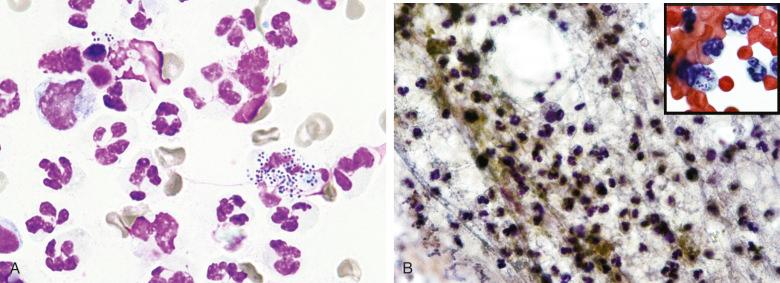
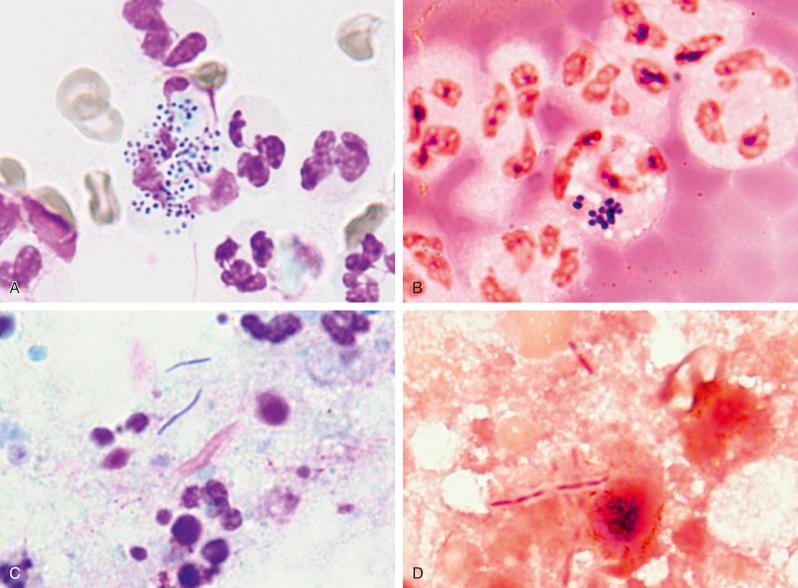
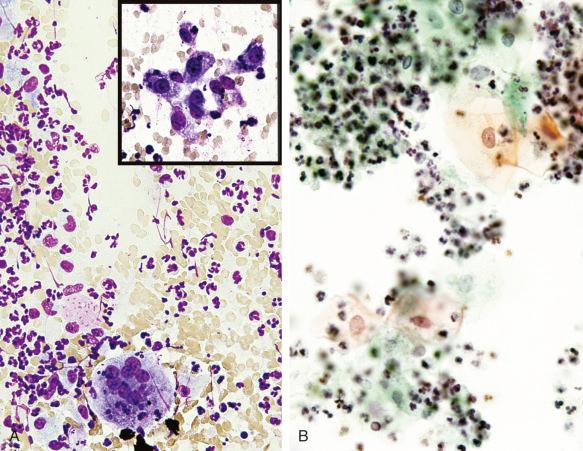
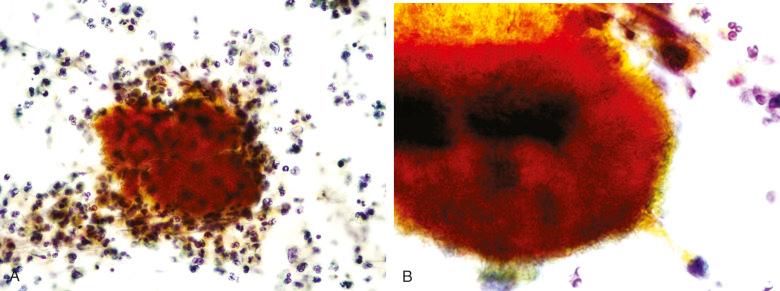
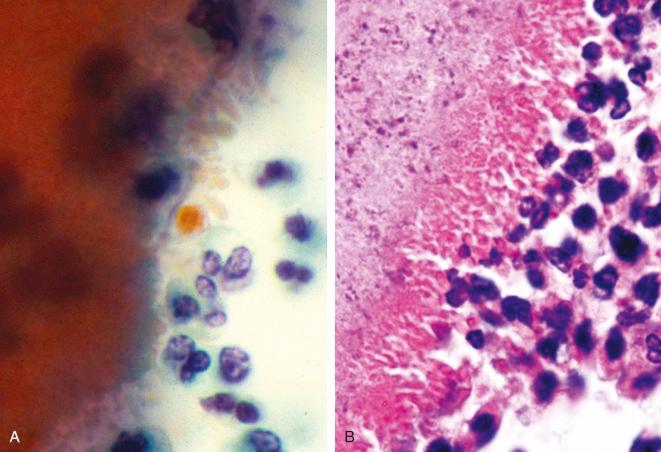
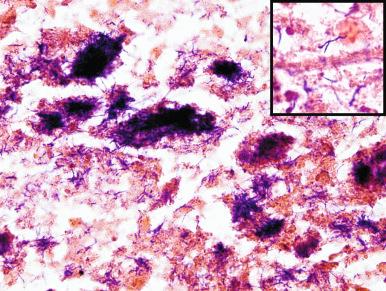

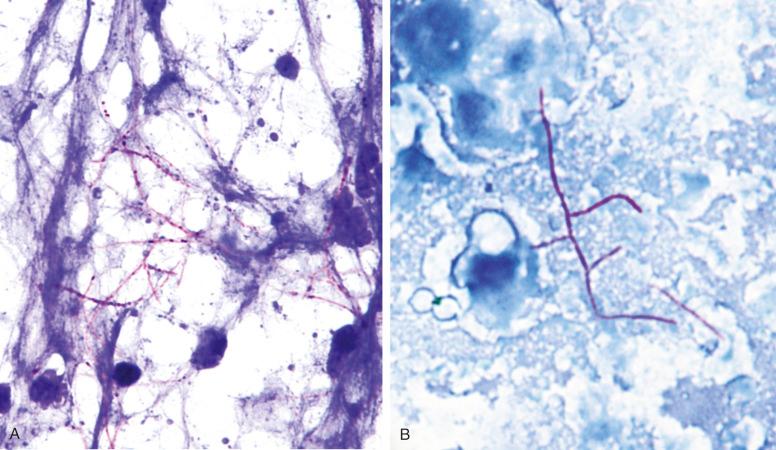
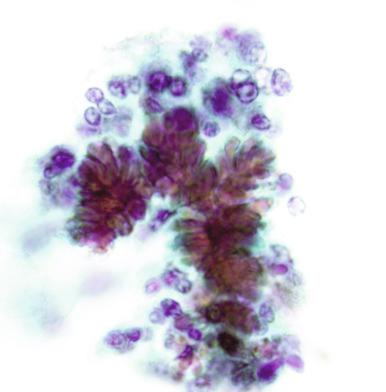
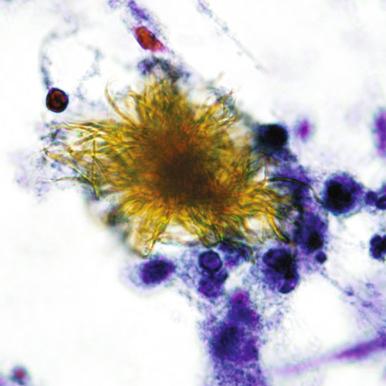
Inflammatory exudates with a predominance of eosinophils are found in asthma and other allergic conditions, including noninvasive allergic fungal diseases; parasitic infections; and eosinophilic pneumonia, and as a nonspecific finding in chronic pleural effusions of varying etiologies including, but not limited to, pneumothorax. One should remember that where there are Charcot-Leyden crystals, there are eosinophils, and where there are eosinophils, one must look for allergic disease and parasites. Charcot-Leyden crystals are elongated, dipyramidal to rectangular crystals with pointed or raggedy ends, quite variable in size. They are composed of lysolecithin acylhydrolase, which has lysophospholipase, an enzyme important in the antiparasitic, antineoplastic, and immune functions of eosinophils. In Romanowsky-stained preparations, they have a light blue color, and in Papanicolaou stain, they may be orange or turquoise. Cases that exemplify eosinophil-rich disease processes diagnosed by cytology, visceral larva migrans–associated eosinophilic hepatic pseudotumor, and allergic fungal disorders are described here. It should also be noted that eosinophils may be found in inappropriate abundance in certain fungal infections (discussed later), and this finding may portend disseminated disease with poor prognosis.
CT monitoring for hepatocellular carcinoma in a Cambodian man with hepatitis C disclosed a liver mass that was sampled by FNA. Fig. 4.16 illustrates the findings in an onsite rapid Romanowsky stain. ROSE revealed the presence of necrosis and a large number of reddish granules, consistent with degenerating eosinophils, and many Charcot-Leyden crystals. For this reason, cancer was preliminarily rejected, and suspicion turned to parasites. The preliminary diagnosis was hepatic eosinophilic pseudotumor, and visceral larva migrans was included in the final differential diagnosis. Subsequent serotesting for Toxocara was positive, and the nodule regressed with therapy.
Necrosis, necrotic eosinophils, and Charcot-Leyden crystals in a solitary liver nodule, especially from a child or from an adult with recent foreign travel, makes one suspect visceral larva migrans. Nonhuman ascarid larvae are the most common culprits; however, the actual nematode larva is rarely seen, even in histologic preparations. A portion of larva surrounded by abundant eosinophils is seen in Fig. 4.17 . This is a histologic section taken from another case of visceral larva migrans–associated hepatic pseudotumor that was resected without presurgical biopsy or FNA. Nodular collections of eosinophils can also be found in Hodgkin disease and other lymphomas, hypereosinophilic syndrome, and carcinomas, most notably gastric adenocarcinoma. Again, careful attention to patients' clinical history and laboratory findings are essential.
Fig. 4.18 illustrates the bronchial brush findings from an elderly woman who had a pulmonary infiltrate and a history of therapy for uterine cancer. Eosinophils and abundant mucin were found, and a GMS stain was performed over one of the Papanicolaou-stained slides. Mucin, eosinophils, and fungi are consistent with an allergic fungal mucus plug, the differential of which is discussed in the following paragraphs. Fig. 4.19 illustrates an aspiration of sphenoid sinus contents from a 6-year-old boy with a history of allergic rhinitis and multiple paranasal sinus opacifications and cranial nerve palsies. Note the presence of granular debris, necrotic eosinophils, and Charcot-Leyden crystals. Elsewhere in the preparations, fungal hyphae were found, and the patient proved to have a noninvasive condition known as allergic fungal sinusitis. Fig. 4.20 is an aspirate from an ethmoid sinus of another patient with allergic fungal sinusitis. Note the presence of hyaline, cyanophilic hyphae admixed with degenerating eosinophils. Elsewhere in the sample, mucin admixed with relatively intact eosinophils were seen. The fungi proved to be dematiaceous by melanin stain (see Fig. 4.20 , inset).
These three cases illustrate the diagnostic significance of allergic mucin. Allergic mucin, composed of a mixture of mucin, cellular debris, eosinophils, and Charcot-Leyden crystals, is found within the conducting airways in allergic airway diseases. The hallmark of Aspergillus (and other fungal-associated) noninvasive allergic disease is allergic mucin. If one sees allergic mucin and fungi in an FNA or bronchial brushing (see Fig. 4.18 ), as in the case of the elderly woman, allergic bronchopulmonary aspergillosis (ABPA) must be ruled out, and communication with the clinical team is recommended. In 2014, ABPA was redefined by clinical parameters that include history of asthma or cystic fibrosis with deterioration of lung function, immediate Aspergillus species skin test reactivity, increased serum immunoglobulin E (IgE) ≥1000 ng/mL, increased Aspergillus species–specific IgE and IgG antibodies, and chest radiographic infiltrates. Peripheral blood eosinophilia, mucus plugs containing fungus, central bronchiectasis, and Aspergillus serum precipitins can be considered additional criteria.
Bronchial mucoid impaction that demonstrates the presence of allergic mucin and fungi but lacks the other criteria for ABPA may also occur. In the case of the elderly woman, no fungus-specific antibodies were found. Allergic mucin, containing fungal organisms, most commonly dematiaceous fungi, is also seen in allergic fungal sinusitis. This condition is similar to ABPA in that the fungi are noninvasive. Allergic fungal sinusitis symptoms are caused by massive mucus impaction within the paranasal sinuses. The impaction may cause compression of cranial nerves and symptoms suspicious for neoplasia. Evacuation of contents of involved sinuses typically yields grumous material that has been described as foul-smelling and having the consistency of peanut butter. Cytologists should be familiar with the microscopic features of allergic mucin to help to establish the diagnosis of allergic fungal disease and rule out both neoplasia and invasive fungal disease.
Peripheral blood eosinophilia and eosinophils admixed with granulomatous inflammation can be associated with chronic, disseminated coccidioidomycosis and may portend poor prognosis. Figs. 4.21 and 4.22 demonstrate the FNA and lymph node biopsy findings, respectively, in a young man from Mexico who presented with lower extremity lymphedema, eosinophilia, and a history of an unknown type of fungal infection. Granulomatous inflammation and abundant eosinophils were seen, with very focal fungal spherules (not illustrated) present in the biopsy sample. Cultures of lymph node grew C. immitis . Special attention should be paid to the patient's history, to the country of origin or travel, and always to the culture results when inflammation is present.
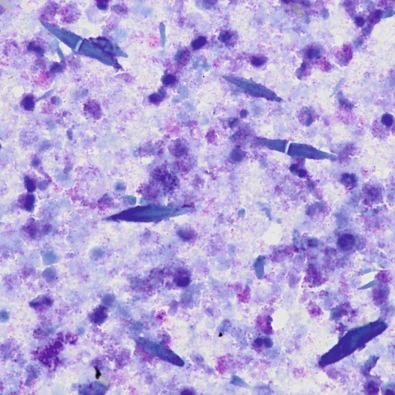
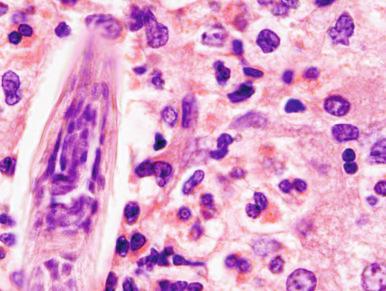
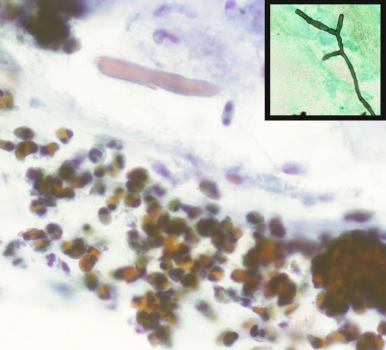
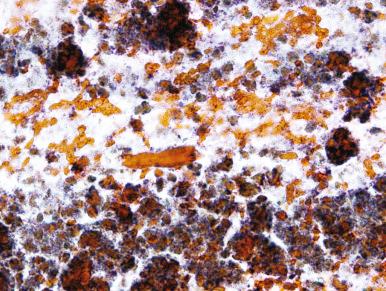
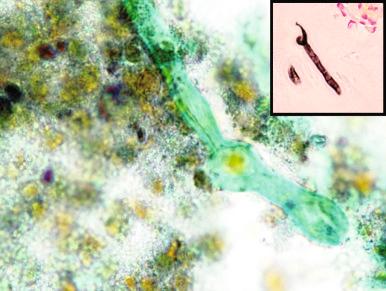
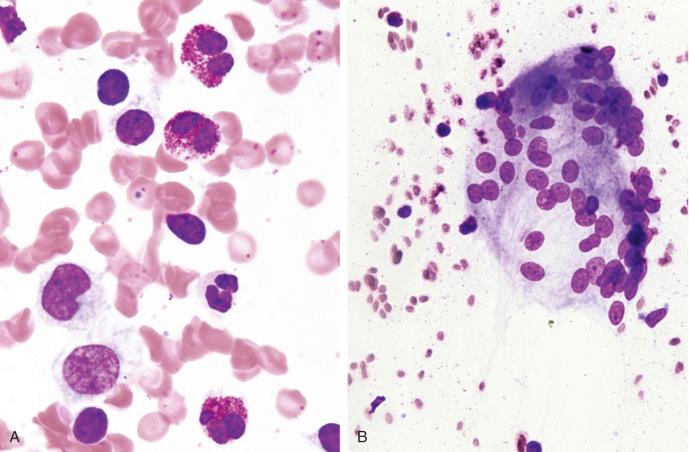
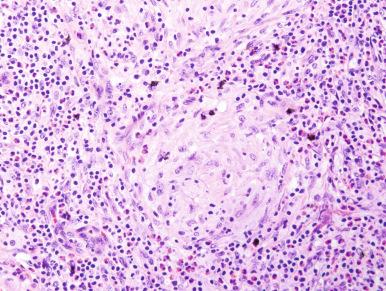
Granulomatous inflammation is a type of chronic inflammation characterized by the presence of immunologically modified macrophages that have increased amounts of cytoplasm and cytoplasmic organelles that form in response to persistent microbial infections or large antigenic particles. The term granuloma is used to describe the aggregation of these modified macrophages into nodular aggregates. Lymphocytes and plasma cells are also seen, usually at the periphery of granulomas. In cytologic preparations the transformed macrophages of granulomas have elongate oval- to boomerang-shaped nuclei and abundant, finely granular cytoplasm that is pink in H&E-stained slides and cyanophilic in Papanicolaou. The cytoplasmic borders are not well defined, and adjacent cells blend into one another. The cells bear some resemblance to epithelial cells and are called epithelioid macrophages . Multinucleated giant cells are often seen but not essential for the diagnosis of granuloma. Two FNA preparations showing noncaseating granulomatous inflammation are illustrated in Fig. 4.23 . The Papanicolaou-stained sample derives from a cervical lymph node in a 33-year-old man who had sarcoidosis. The Romanowsky-stained preparation was taken from a lymph node FNA in a woman with tuberculosis and widespread lymphadenopathy. Noncaseating granulomas found in a lymph-node or visceral-organ FNA from an asymptomatic young person frequently indicates sarcoidosis; however, one must not be complacent. One cannot distinguish between sarcoidosis and infectious causes of noncaseating granulomas on the basis of morphology. Always culture the sample, and be sure that the clinician is aware of the patient's clinical and radiologic findings. Fig. 4.24 is taken from a tonsil biopsy of the man with sarcoidosis. It is easy to see why the term “epithelioid cells” is appropriate!
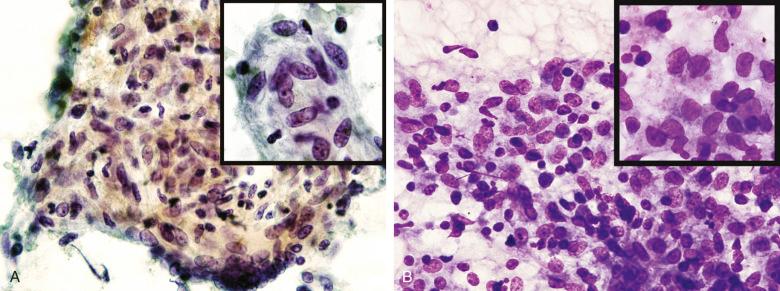
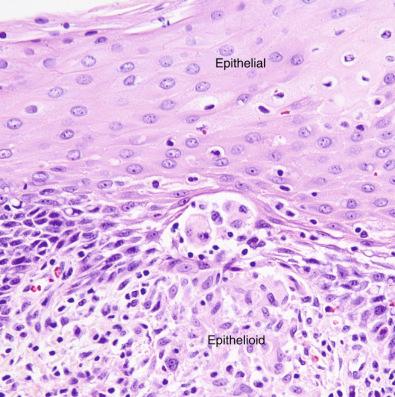
Caseating granuloma refers to the presence of epithelioid macrophages surrounding granular amorphous material that, by gross evaluation, has the appearance of crumbly white cheese. In Papanicolaou-stained cytologic preparations, caseating necrosis has a granular, gray-green appearance ( Fig. 4.25 ). Entrapped, degenerated cells are seen, and, with luck, some epithelioid macrophages may be found. It is very important to recognize caseation in a cytologic preparation because acid-fast and fungal staining are indicated. In Romanowsky-stained preparations, caseous material is more faintly stained, usually rather pink, but the gross appearance of the material expelled from the FNA needle often provides a clue. It is creamy, somewhat granular, and often drier in appearance than pus. If the Romanowsky stain (see Fig. 4.25 , inset) fails to demonstrate neutrophils and abundant amorphous material is seen in a compatible clinical setting, one should suspect caseation and request mycobacterial and fungal cultures. Epithelioid cell aggregates without caseation may be found in aspirates from chronic coccidioidomycosis, blastomycosis, and histoplasmosis. A presumptive diagnosis of sarcoidosis and therapy with steroids can prove deadly in patients with disseminated tuberculosis or fungal infection.
A 73-year-old man had complained of weight loss and cough. By CT, he was found to have a thick-walled cavitary mass in the right upper lung and two smaller masses near the pleura. Clinicians were concerned about cavitary SCC. A bronchial brushing slide contained the findings illustrated in Fig. 4.26A . Note the loosely formed epithelioid cells with interspersed granular material, indicative of caseating granuloma. Scanty acid-fast bacilli were seen on a Kinyoun stain performed over a Papanicolaou-stained brushing slide. Culture of the respiratory material from bronchoscopy grew Mycobacterium avium complex (MAC), and the cavity wall markedly thinned after therapy; however, 1 year later, a dependent, bulbous mass appeared within the base of the cavity. FNA revealed the presence of branching septate hyphae, and the diagnosis rendered was fungus ball arising in a preexisting cavity.
A 41-year-old woman also presented with cough and chest CT interpreted as suspicious for bronchogenic carcinoma. Abundant caseous material with reactive squamous metaplasia was seen (see Fig. 4.26B ). Acid-fast bacilli were seen on Kinyoun stain performed over Papanicolaou-stained slides of bronchial brushing and bronchial washing samples, but culture of bronchoscopic material was not performed. One must keep in mind that mycobacterial infections can mimic neoplasia and that granular amorphous material in an FNA, bronchial brush, or transbronchial fine needle aspiration (TBNA) sample should lead one to request acid-fast (and fungal) stains as well as cultures. Caseation may, at times, be difficult to distinguish from coagulative tumor necrosis; however, outlines of necrotic neoplastic cells can usually be seen in the latter. Note that had ROSE been performed during bronchoscopy and caseous-like necrosis or granuloma been identified, the clinicians would have been instructed to culture bronchial brushing and washings. The following two caveats should be kept in mind:
Reactive squamous metaplasia can lead to misdiagnosis of SCC in cases of infections. We have seen markedly atypical squamous metaplasia associated with tuberculosis and actinomycosis.
MAC cannot be accurately distinguished from M. tuberculosis complex (MTC) by acid-fast stain, and MAC infections are not confined to severely Tcell–immunosuppressed patients. Culture is required for identification of MOTT, and culture or presumptive identification by molecular methods, such as RNA amplification for MTC. Mycobacterium kansasii has a distinct morphology that can allow for presumptive diagnosis in some cases, and MFC closely resembles Nocardia spp., as mentioned previously. The comparative acid-fast staining features of MTC, MAC, and M. kansasii are shown in Fig. 4.27 . All slides were taken from cytologic samples.
Fig. 4.28 illustrates the TBNA and transbronchial biopsy findings from a man with AIDS and mediastinal lymphadenopathy. Lymphoma was suspected. Note the presence of spindle-shaped cells that could be misinterpreted as an Epstein-Barr–associated smooth muscle tumor or Kaposi sarcoma. The spindle cells in this type of pseudotumor have immunohistochemical features of macrophages ; in an AIDS patient, they are highly suspicious for mycobacterial infection. MTC, MAC, and M. kansasii have all been isolated from patients with so-called spindle cell granulomas. In this case, very long, coarsely beaded, acid-fast bacilli with curved ends are seen. Their shape has been compared to a shepherd's crook, although a Christmas candy cane might be a better simile. This is the classic appearance of M. kansasii and is the only type of mycobacteria for which we can usually make a presumptive species identification on the basis of morphology. MFC also has a relatively unique appearance; however, as previously stated, differentiation from Nocardia is problematic.
A 37-year-old HIV-seronegative man was referred for evaluation of an abnormal chest radiograph. CT showed multiple bilateral pulmonary opacities 1 to 4 cm in diameter ( Fig. 4.29 ). An atypical infectious process was favored, and a CT-guided FNA was performed. Findings are illustrated in Fig. 4.30 . This patient was immunocompetent, and epithelioid macrophages, giant cells, lymphocytes, and plasma cells were present, consistent with granulomatous inflammation; however, the macrophage cytoplasm had a vesiculated rather than granular appearance. To best see the intracytoplasmic structures, the substage condenser must be closed. This gives fungi a refractile appearance and makes them much easier to see. On high-power examination, one sees relatively round structures that are clear to slightly pink. The fungi lack abundant capsular material, as is common in infections with this pathogen in immunocompetent or mildly immunosuppressed patients. Note the considerable variation in size, a very important clue to the diagnosis! These organisms typically vary from 5 to 20 µm in diameter. This is well demonstrated in the GMS stain ( Fig. 4.31 ). Also note the thin cell wall and round shape, which are typical of Cryptococcus . Cryptococcus infection in T cell–immunosuppressed patients is discussed in the next section.
One should be aware that cryptococci are easily overlooked in H&E- and Papanicolaou-stained preparations. They may also be mistaken for phagocytized erythrocytes or lipid ( Fig. 4.32 ). Remember to close the substage condenser! Paucicapsular forms of Cryptococcus often stain weakly with mucicarmine. Fontana-Masson melanin stain is recommended in these cases. Remember, the marked variation in diameter of cryptococcal yeast forms helps one to distinguish this fungus from both erythrocytes and other yeastlike pathogens.
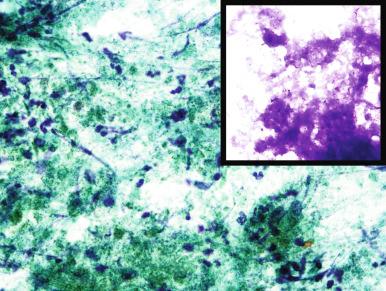
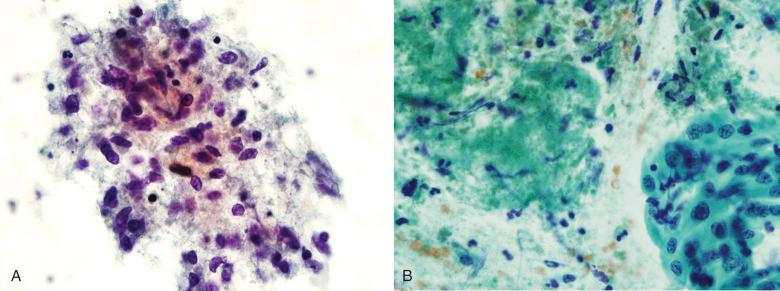

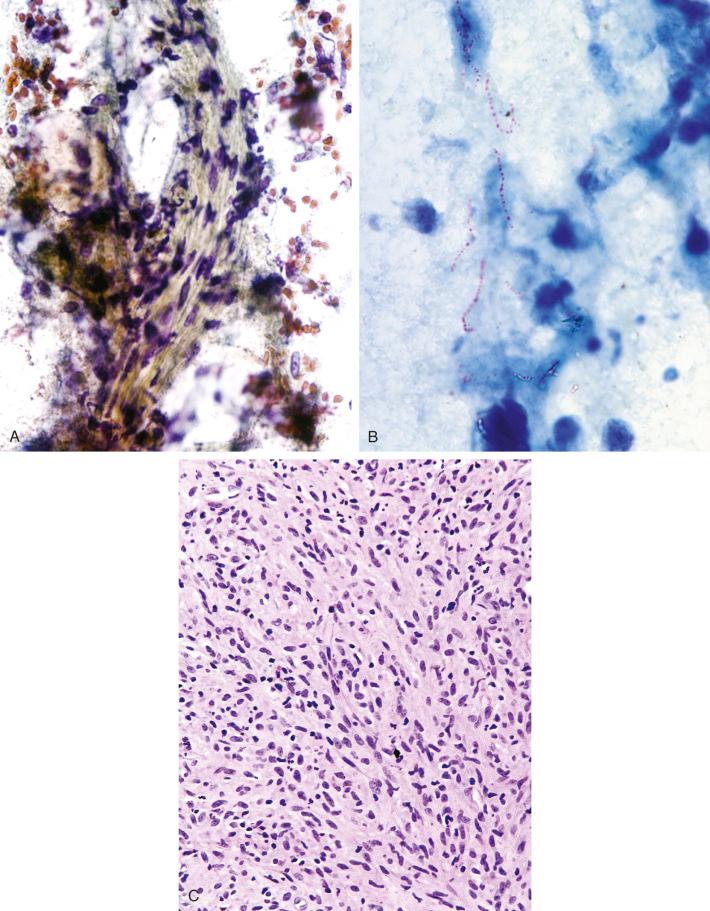
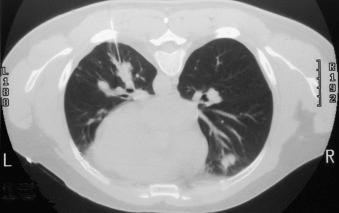
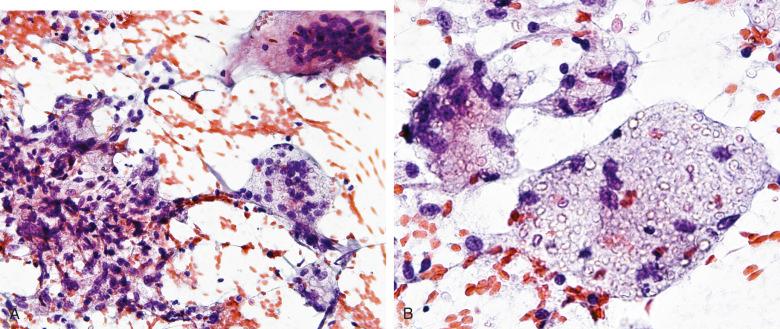
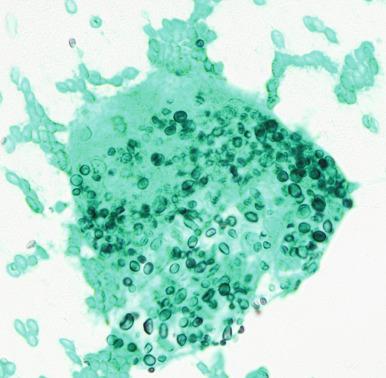
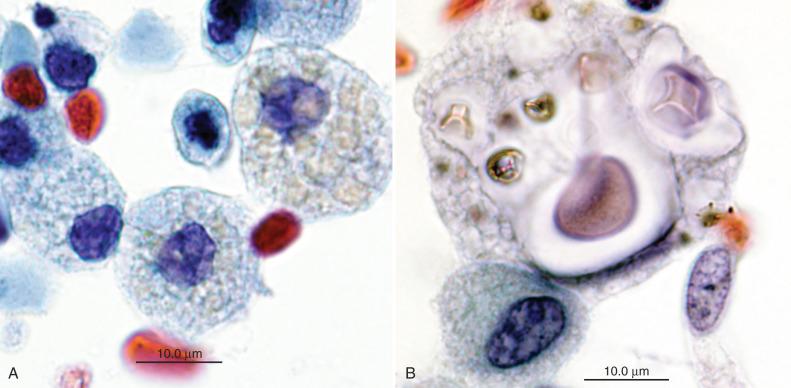
A mixture of epithelioid macrophages and neutrophils is the typical inflammatory response to many of the dimorphic fungi, including C. immitis, Blastomyces dermatitidis, Paracoccidioides brasiliensis, Sporothrix schenckii, and the dematiaceous fungi associated with chromoblastomycosis and phaeohyphomycosis. Neutrophils are rarely seen in cases of histoplasmosis or cryptococcosis. H. capsulatum and Cryptococcus neoformans usually elicit either a granulomatous, diffuse macrophage reaction or, in the case of Cryptococcus , scant to absent inflammation. Diffuse macrophage infiltration, typically found in patients with deficient Th1 cell-mediated immunity, is discussed in the following section. In dimorphic fungal infections, the proportion of epithelioid macrophages to neutrophils varies with the host's ability to interact with the pathogen. In chronic, indolent infections, one sees a predominance of granulomatous inflammation. In fulminant infections, neutrophils predominate. In advanced AIDS, abundant necrosis admixed with myriad fungi and varying numbers of neutrophils is typical.
It is important that the cytologist know which stains best demonstrate the features of the dimorphic fungi. Although GMS is often considered the gold standard and is very sensitive, it is not the best stain for assessment of distinctive fungal features. C. immitis, B. dermatitidis, and P. brasiliensis are best seen on H&E or Papanicolaou stain. These stains allow one to scrutinize the internal features of the organisms, including cell wall, endoplasm, and nuclei. In the case of C. immitis , endospore formation can be seen. Agents of chromoblastomycosis and phaeohyphomycosis, dematiaceous fungi, are also usually well seen on H&E and Papanicolaou stains. Chromoblastomycosis pertains to infections localized to the epidermis and dermis and is characterized by presence of multiseptate bodies or Medlar bodies. Phaeohyphomycosis pertains to subcutaneous or visceral infections. In phaeohyphomycosis, hyphae and moniliform pseudohyphae usually predominate; however, we have seen multiseptate bodies admixed with hyphae in an FNA in one case of disseminated phaeohyphomycosis caused by Fonsecaea pedrosoi . Fig. 4.33 shows the comparative features of B. dermatitidis, C. immitis, and P. brasiliensis , which can easily be confused in cytologic or histologic preparations. Note the pseudococcioidoid, nonbudding Blastomyces in Fig. 4.33D and the paired pseudoblastomycoid Coccidioides immature spherules in Fig. 4.33E . Cryptococcus rarely is confused with these in H&E- or Papanicolaou-stained material because it lacks a thick, double refractile cell wall, but an image is included (see Fig. 4.33F ) to illustrate the contrast between C. neoformans and the others. In GMS-stained preparations, differentiation of yeastlike fungi is more problematic. Sporothrix schenkii , usually a localized skin pathogen, can infrequently cause pulmonary or disseminated infections and may be difficult to distinguish from other dimorphic fungi by GMS stain and difficult to visualize by routine stains. In GMS, it is usually 3 to 5 µm in width and may demonstrate elongated, “cigar-shaped” blastoconidia (See Appendix ).
A 21-year-old male student from eastern Louisiana underwent bronchoscopy because of a right lower lung infiltrate, chills, and fever that failed to respond to therapy for community-acquired pneumonia. The man had no history of alcohol or drug abuse and was HIV negative. His bronchial brushing material is illustrated in Fig. 4.34 . Note the combination of epithelioid macrophage aggregates and neutrophils (see Fig. 4.34A ). This type of inflammatory pattern and the clinical history should generate a search for dimorphic fungi. In Fig. 4.34B, one sees the characteristic features of B. dermatitidis . In tissue, B. dermatitidis is seen as yeastlike cells that are 8 to 15 µm in length and relatively uniform in size (in contrast to Cryptococcus, Coccidioides spherules, and Paracoccidioides ); the cell wall is thick and double contoured, and the endoplasm is typically retracted so as to leave a clear zone between the cell wall and the internal structures (see Fig. 4.33A and D ). Under very high magnification, multiple nuclei can sometimes be seen as tiny dots, but these may be difficult to discern in Papanicolaou and H&E stains. Broad-based budding is typical of Blastomyces and is useful if found (see Fig. 4.33A ). The main differential includes P. brasiliensis and C. immitis (see Fig. 4.33 ). Because these organisms have different geographic distributions, knowing the travel history or region of birth of the patient is extremely helpful. P. brasiliensis is thick-walled like B. dermatitidis , but it has narrow-necked budding, and multiple buds are common. The characteristic “ship's wheel” budding pattern is lovely and diagnostic if you can find it, but it may be difficult to find. A very useful differentiating feature is the marked variability in size that is found in P. brasiliensis compared with B. dermatitidis . The greatest diagnostic pitfall is the immature spherule of C. immitis , which may closely resemble B. dermatitidis and P. brasiliensis (see Fig. 4.33 ). The Paracoccidioides yeast forms illustrated here derive from a lung section rather than a cytologic specimen and are shown for the sake of comparison.
A 26-year-old man who had been working in the Texas Rio Grande Valley presented with fever and several fluctuant, subcutaneous masses. Chest radiography revealed diffuse interstitial infiltrates. FNA was performed from a 3 × 3 cm subcutaneous mass overlying the fifth lumbar vertebra. Several milliliters of gray-colored, thick material were aspirated. A Papanicolaou-stained slide of aspirate is illustrated in Fig. 4.35 . Spherules of markedly varying sizes are seen in a background of necrosis, giant cells, and neutrophils. Endosporulation is seen within some of the spherules. Note that immature and empty spherules that lack endosporulation can readily be mistaken for pollen grains, Blastomyces , or Paracoccidioides . Cutaneous and subcutaneous lesions of Blastomyces, Paracoccidioides, and Coccidioides typically represent disseminated pulmonary disease; however, in some cases, pulmonary lesions are not apparent. This was a fulminant case, and neutrophils and necrosis are prominent, although epithelioid macrophages and giant cells are also seen.
This patient tested negative for HIV. In patients with coccidioidomycosis and advanced AIDS, extensive necrosis, myriad organisms, and variable numbers of neutrophils and macrophages are seen. Granulomas are absent ( Fig. 4.36 ). Similar histologic reactions to Paracoccidioides, Blastomyces, and Sporothrix have been reported in AIDS patients.
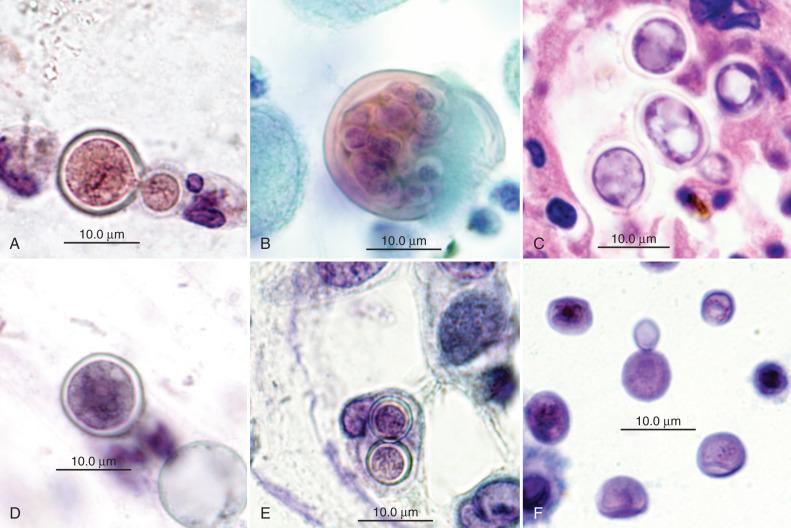
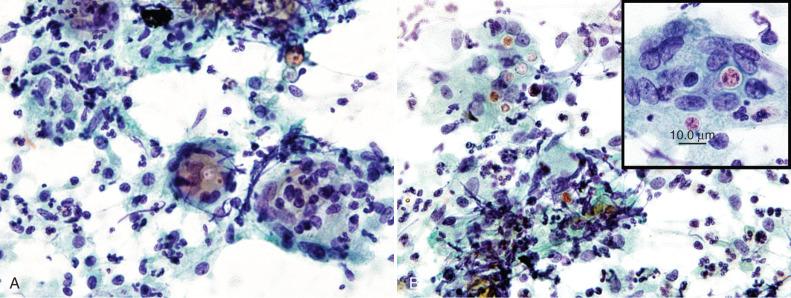
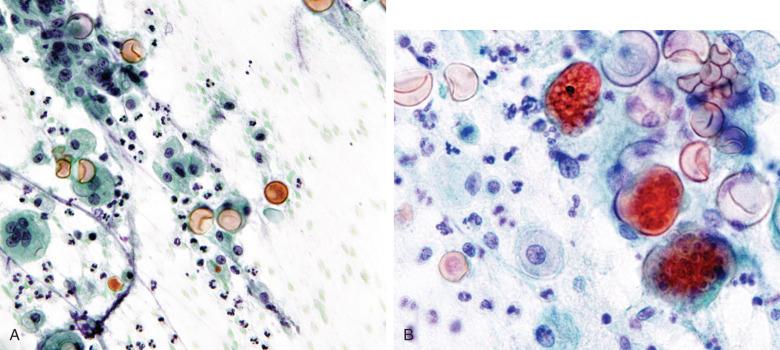
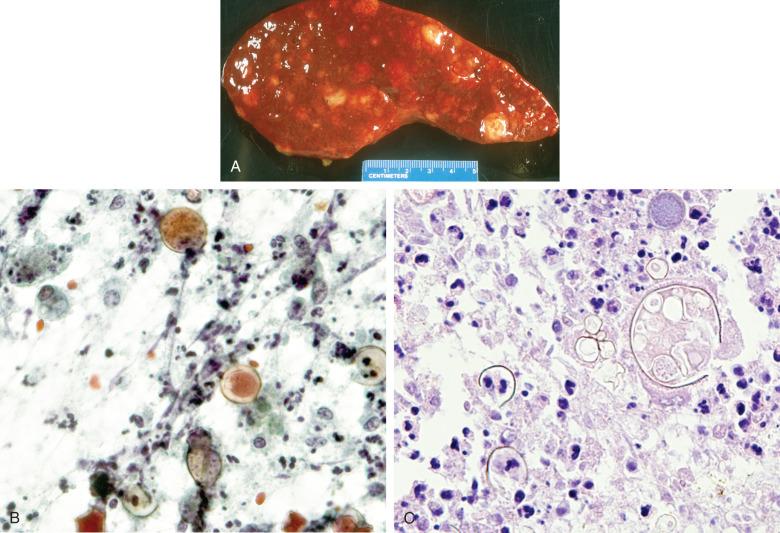
Neutropenic patients are susceptible to a number of infections, including pyogenic bacteria, invasive aspergillosis, candidiasis, and mucormycosis. In these patients, one sees abundant organisms but not the expected purulent inflammatory reaction. Patients with adequate numbers of neutrophils but defective neutrophil function (e.g., in diabetes) also are at risk for invasive infections with these fungi. Vascular invasion is typical of invasive aspergillosis, candidiasis, and mucormycosis, although this phenomenon is usually appreciated on histologic sections rather than in the cytology laboratory. However, we have demonstrated fungi within rounded infarcts and thrombosed blood vessels by postmortem cytology. Fig. 4.37 shows the gross and scrape preparation findings from the autopsy of a severely neutropenic patient with multiple round pulmonary infarcts and vascular thromboses. Fungal hyphae were found within the infarcts and blood vessels by cytology. Examination of sections confirmed the presence of invasive fungal disease. Postmortem cultures grew Aspergillus glaucus . Normally, the clinical history and radiologic features are needed to differentiate between aggressive, invasive fungal disease and more indolent invasive disease, such as chronic necrotizing aspergillosis or intrabronchial zygomycosis. However, using the clinical and radiologic information, the cytologist can and should discuss the possibilities with the clinician. The variety of diseases associated with Aspergillus alone is mind boggling and includes noninvasive fungus ball, ABPA and mucoid impaction, chronic necrotizing aspergillosis, ulcerative bronchitis, and aggressive invasive aspergillosis, to name a few. It is important to note that there are cases of chronic necrotizing zygomycosis that are analogous to chronic necrotizing aspergillosis. These tend to occur in patients with mild neutrophil dysfunction as occurs in diabetes mellitus. Allergic disease can be diagnosed on the basis of allergic mucin, as discussed previously; however, the other potential diagnoses require careful clinical correlation. By tissue morphology alone, Aspergillus cannot be definitively differentiated from other hyalohyphal fungi unless conidia-bearing fruiting heads are seen. Fig. 4.38 demonstrates conidiophores and fruiting heads of Aspergillus fumigatus found in a bronchial brushing from a patient with endobronchial aspergillosis. This finding so mesmerized the cytopathologist that the cells deriving from small cell carcinoma, also present in the preparation, were overlooked. Zygomycetes, as a group, can be differentiated from other mycelia-producing fungi ( Fig. 4.39 ); however, the genus cannot be identified in the absence of fruiting heads. Although the hyphal structures of zygomycetes and aspergillus (or other non-zygomycete hyalohyphal fungi) can be confused in tissue sections, it has been our experience that confusion is less likely in cytologic preparations, owing to the greater thickness and transparency of Papanicolaou-stained smears and the dense, often yellow-orange staining of zygomycetes ( Fig. 4.39A ). Dematiaceous fungi responsible for phaeohyphomycosis can often be differentiated from hyalohyphal fungi by the presence of light brown pigmented cell walls, presence of moniliform pseudohyphae, and positive melanin staining; however, neither genus nor species can be determined by tissue morphology. Fig. 4.39C illustrates the FNA findings from a case of subcutaneous phaeohyphomycosis.
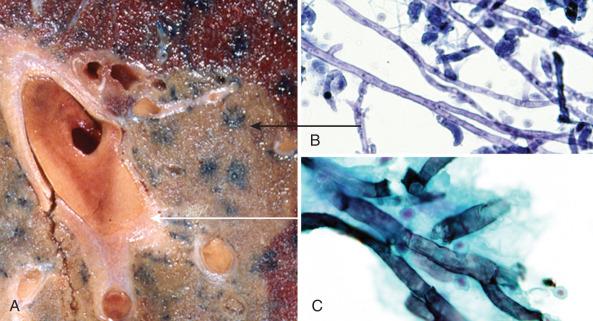
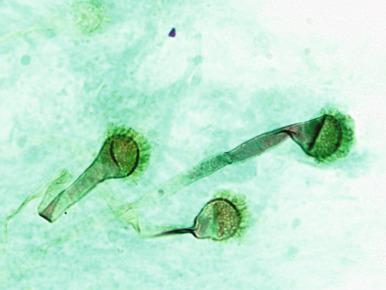
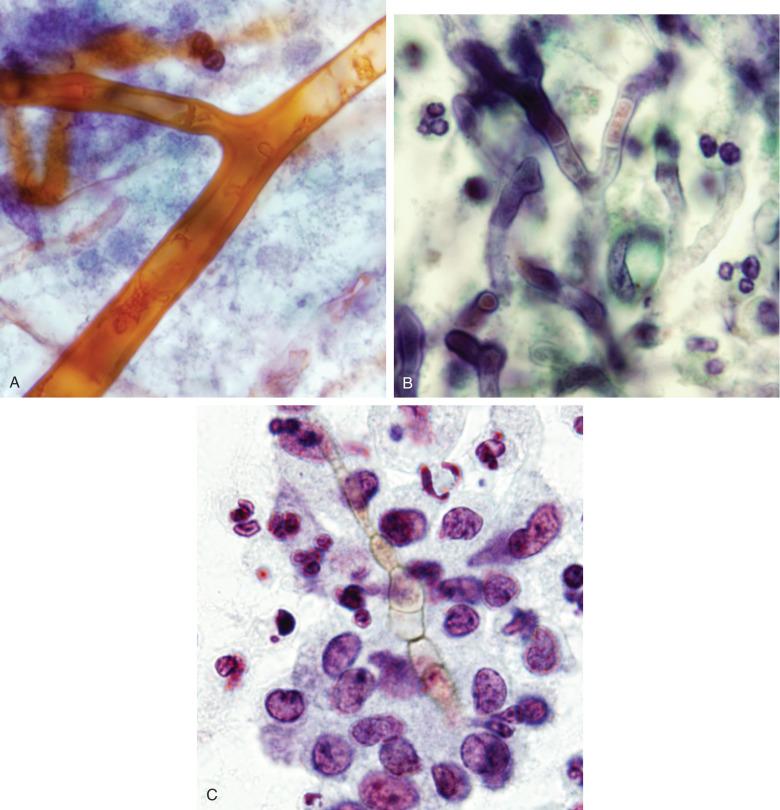
Candida infections ( Fig. 4.40A,B, and D ) can be superficial and limited to the epithelium of mucous membranes, as in thrush and vulvovaginitis, or they can be locally invasive or aggressive, with vascular invasion and hematogenous dissemination. Candida found in cervical Pap test slides usually derives from a superficial infection, and aggregates or stacks of squamous cells are seen entangled in pseudohyphae, often with scanty inflammation. Vaginal candidiasis is discussed elsewhere in this text. Candida vaginitis is rarely misdiagnosed as another type of infection, but we have seen a couple of instances of spermatozoa misinterpreted as Candida in liquid-based preparations. In liquid-based cervical Pap tests, Candida yeast forms usually have a reddish homogeneous staining and budding can be demonstrated because spermatozoa heads tend to have a two-toned, blue-clear appearance and occasionally a tail can be seen ( Fig. 4.40C and D ). Invasive candidiasis cannot be distinguished from upper tract contamination or superficial candidiasis on the basis of brushings, washings, or BAL; however, the finding of blastoconidia and pseudohyphae in a visceral organ aspirate or an ulcerative lesion with pseudomembrane formation should suggest invasive fungal infection in the proper clinical setting. Fig. 4.40E illustrates the postmortem scrapings from the rectum of a severely neutropenic patient with ulcerative, pseudomembranous lesions of the esophagus and rectum. In the Papanicolaou-stained sample, note the fibrinous exudate associated with presence of colonic-type columnar epithelium and fungal pseudohyphae. Cytologic evaluation of ulcer scrapings allowed for a preliminary diagnosis of candidiasis and excluded other causes of ulcerative mucosal lesions (e.g., herpesvirus, cytomegalovirus). On the basis of the gross appearance, at least superficial invasive disease was suspected. Candidiasis was confirmed by histologic sections examined subsequently. Papanicolaou- and Romanowsky-stained esophageal endoscopic scrapings are routinely used at our institution for presumptive diagnosis of esophageal candidiasis and to rule out Herpes esophagitis. The only fungus likely to be confused with Candida is Trichosporon , which can cause invasive disease in immunosuppressed hosts. Differentiation is by culture and the slightly larger size, greater pleomorphism, and presence of arthroconidia in GMS-stained preparations of Trichosporon .
A 37-year-old diabetic man presented with isolated solitary pulmonary and renal lesions. Sputum, urine, and kidney FNA contained zygomycete fungi. Urine and kidney FNA findings are seen in Fig. 4.41 . Note the presence of neutrophils and broad, well-stained, ribbonlike hyphae typical of zygomycetes. This patient proved to have locally invasive intrabronchial zygomycosis with an isolated mycotic renal abscess. Cultures of both sites grew Rhizopus spp. This case illustrates an unusual, indolent presentation of zygomycosis in a nonneutropenic patient who had diabetes mellitus. Cytologic examination could only diagnose zygomycosis. Histologic studies of the resected lung lesion demonstrated chronic, intrabronchial zygomycosis, a condition analogous to chronic necrotizing aspergillosis. The kidney lesion was also resected, and no evidence of other infected sites was found subsequently.
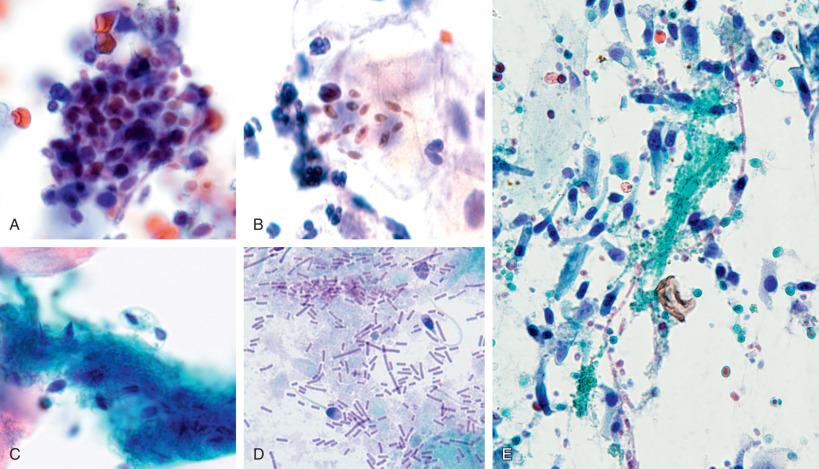
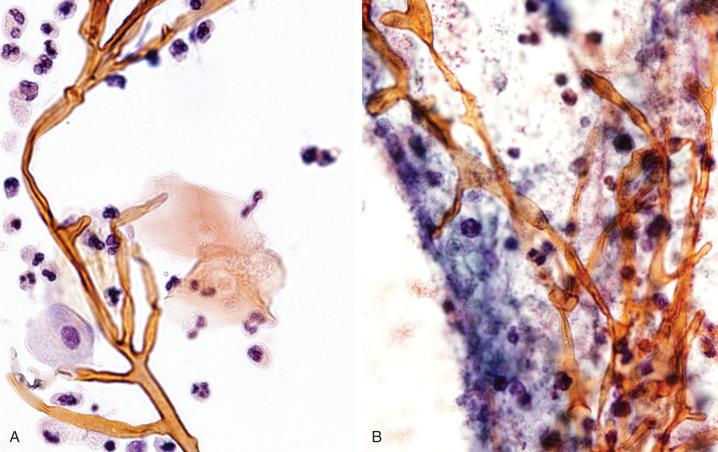
Become a Clinical Tree membership for Full access and enjoy Unlimited articles
If you are a member. Log in here